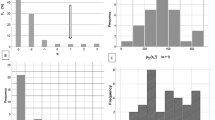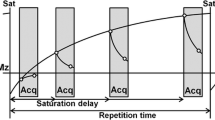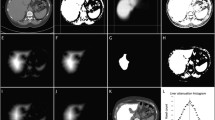Abstract
Post-mortem body cooling is the foundation of temperature-based death time estimations (TDE) in homicide cases. Forensic science generally provides two types of p.m. body cooling models, the phenomenological and the physical models. Since both of them have to implement important individual parameters like the quantity of abdominal fat explicitly or implicitly, a more exact quantification and localization of abdominal fat is a desideratum in TDE. Particularly for the physical models, a better knowledge of the abdominal fat distribution could lead to relevant improvements in TDEs. Modern imaging methods in medicine like computed tomography (CT) are opening up the possibility to register the quantity and spatial distribution of body fat in individual cases with unprecedented precision. Since a CT-scan of an individual’s abdominal region can comprise 1000 slices as an order of magnitude, it is evident that their evaluation for body fat quantification and localization needs fully automated algorithms. The paper at hand describes the development and validation of such an algorithm called “CT-histogram-based fat estimation and quasi-segmentation” (CFES). The approach can be characterized as a weighted least squares method dealing with the gray value histogram of single CT-slices only. It does not require any anatomical a priori information nor does it perform time-consuming feature detection on the CT-images. The processing result consists in numbers quantifying the amount of abdominal body fat and of muscle-, organ-, and connective tissue. As a by-product, CFES generates a quasi-segmentation of the slices processed differentiating fat from muscle-, organ-, and connective tissue. The tool is validated on synthetic data and on CT-data of a special phantom. It was also applied on a CT-scan of a dead body, where it produced anatomically plausible results.











Similar content being viewed by others
References
Marshall TK, Hoare FE (1962) Estimating the time of death—the rectal cooling after death and its mathematical expression. J Forensic Sci 7:56–81
Marshall TK, Hoare FE (1962) Estimating the time of death—the use of the cooling formula in the study of postmortem cooling. J Forensic Sci 7:189–210
Marshall TK, Hoare FE (1962) Estimating the time of death—the use of body temperature in estimating the time of death. J Forensic Sci 7:211–221
Henßge C (1979) Die Präzision von Todeszeitschätzungen durch die mathematische Beschreibung der rektalen Leichenabkühlung. Z Rechtsmed 83:49–67
Mall G, Eisenmenger W (2005) Estimation of time since death by heat-flow finite-element model. Part I: method, model, calibration and validation. Legal Med 7:1–14. https://doi.org/10.1016/j.legalmed.2004.06.006
Mall G, Eisenmenger W (2005) Estimation of time since death by heat-flow finite-element model. Part II: application to non-standard cooling conditions and preliminary results in practical casework. Legal Med 7:69–80. https://doi.org/10.1016/j.legalmed.2004.06.007
Smart JL (2010) Estimation of time of death with a Fourier series unsteady-state heat transfer model. J Forensic Sci 55:1481–1487. https://doi.org/10.1111/j.1556-4029.2010.01467.x
Schenkl S, Muggenthaler H, Hubig M, Erdmann B, Weiser M, Zachow S, Heinrich A, Güttler FV, Teichgräber U, Mall G (2017) Automatic CT-based finite element model generation for temperature-based death time estimation: feasibility study and sensitivity analysis. Int J Legal Med 131:699–712. https://doi.org/10.1007/s00414-016-1523-0
Aparicio HJ, Himali JJ, Beiser AS et al (2017) Overweight, obesity, and survival after stroke in the Framingham heart study. J Am Heart Assoc 6. https://doi.org/10.1161/jaha.116.004721
Wohlfahrt-Veje C, Tinggaard J, Winther K et al (2014) Body fat throughout childhood in 2647 healthy Danish children: agreement of BMI, waist circumference, skinfolds with dual X-ray absorptiometry. Eur J Clin Nutr 68:664–670. https://doi.org/10.1038/ejcn.2013.282
Hasse J (1995) Accuracy of subcutaneous fat measurement: comparison of skinfold calipers, ultrasound, and computed tomography. Orphanidou C, McCargar, Birmingham CL, et al. University of British Columbia and St. Paul's Hospital, Vancouver. Nutrition in Clinical Practice 10: 161-162. https://doi.org/10.1177/088453369501000414
Borkan GA, Gerzof SG, Robbins AH, Hults DE, Silbert CK, Silbert JE (1982) Assessment of abdominal fat content by computed tomography. Am J Clin Nutr 36:172–177
Hofer M (2010) CT-Kursbuch. Didamed-Verlag Düsseldorf
Press WH, Teukolsky SA, Vetterling WT, Flannery BP (1992) Numerical recipes in C: the art of scientific computing, 2nd edn. Press Syndicate of the University of Cambridge, New York
Hubig M, Muggenthaler H, Sinicina I, Mall G (2015) Temperature based forensic death time estimation: the standard model in experimental test. Legal Med 17:381–387. https://doi.org/10.1016/j.legalmed.2015.05.005
Otsu N (1979) A threshold selection method from gray-level histograms. IEEE Trans Syst Man Cybern SMC-9(1):62–66
Mitsiopoulos N, Baumgartner RN, Heymsfield SB, Lyons W, Gallagher D, Ross R (1998) Cadaver validation of skeletal muscle measurement by magnetic resonance imaging and computerized tomography. J Appl Physiol 85:115–122
Rogalla P, Meiri N, Hoksch B, Boeing H, Hamm B (1998) Low-dose spiral computed tomography for measuring abdominal fat volume and distribution in a clinical setting. Eur J Clin Nutr 52:597–602
Yoshizumi T, Nakamura T, Yamane M, Islam AHMW, Menju M, Yamasaki K, Arai T, Kotani K, Funahashi T, Yamashita S, Matsuzawa Y (1999) Abdominal fat: standardized technique for measurement at CT. Radiology 211(1):283–286
Glasbey CA, Robinson CD (2002) Estimators of tissue proportions from X-ray CT images. Biometrics 58:928–936
Allen P, Branscheid W, Dobrowolski A, Horn P, Romvari R (2004) Schlachtkörperwertbestimmung beim Schwein – Röntgen-Computertomographie als mögliche Referenzmethode. Fleischwirtschaft 84(3):109–112
Romvári R, Dobrowolski A, Repa I et al (2006) Development of a computed tomographic calibration method for the determination of lean meat content in pig carcasses. Acta Vet Hung 54:1–10. https://doi.org/10.1556/AVet.54.2006.1.1
Johansen J, Egelandsdal B, Roe M, Kvaal K, Aastveit AH (2007) Calibration models for lamb carcass composition analysis using computerized tomography (CT) imaging. Chemom Intell Lab Syst 87:303–311
Kongsro J, Røe M, Aastveit AH, Kvaal K, Egelandsdal B (2008) Virtual dissection of lamb carcasses using computer tomography (CT) and its correlation to manual dissection. J Food Eng 88:86–93
Pednekar A, Bandekar AN, Kakadiaris IA, Naghavi M (2005) Automatic segmentation of abdominal fat from CT data. Proceedings of the Seventh IEEE Workshop on Applications of Computer Vision (WACV/MOTION’05), 2005 WACV/MOTIONS ’05 Volume 1 Seventh IEEE: pp. 308–315
Ohshima S, Yamamoto S, Yamaji T et al (2008) Development of an automated 3D segmentation program for volume quantification of body fat distribution using CT. Jpn J Radiol Technol 64:1177–1181
McEvoy FJ, Madsen MT, Strathe AB, Svalastoga E (2008) Hounsfield unit dynamics of adipose tissue and non-adipose soft tissues in growing pigs. Res Vet Sci 84:300–304
McEvoy FJ, Madsen MT, Nielsen MB, Svalastoga E (2009) Computer tomographic investigation of subcutaneous adipose tissue as an indicator of body composition. Acta Vet Scand 51:28. https://doi.org/10.1186/1751-0147-51-28
Cecchini S, Cavazzini E, Marchesi F, Sarli L, Roncoroni L (2011) Computed tomography volumetric fat parameters versus body mass index for predicting short-term outcomes of colon surgery. World J Surg 35:415–423. https://doi.org/10.1007/s00268-010-0888-3
Kanaly CW, Ding D, Mehta AI, Waller AF, Crocker I, Desjardins A, Reardon DA, Friedman AH, Bigner DD, Sampson JH (2011) A novel method for volumetric MRI response assessment of enhancing brain Tumors. PLoS ONE 6(1):e16031. https://doi.org/10.1371/journal.pone.0016031
Subramaniam K, Hoffman EA, Tawhai MH (2012) Engineering in medicine and biology society (EMBC), 2012 Annual International Conference of the IEEE San Diego, California USA, 28 August - 1 September, 4072-4089. https://doi.org/10.1109/EMBC.2012.6345869
Kim YJ, Lee SH, Kim TY, Park JY, Choi SH, Kim KG (2013) Body fat assessment method using CT images with separation mask algorithm. J Digit Imaging 26:155–162. https://doi.org/10.1007/s10278-012-9488-0
Kullberg J, Hedström A, Brandberg J, Strand R, Johansson L, Bergström G, Ahlström H (2017) Automated analysis of liver fat, muscle and adipose tissue distribution from CT suitable for large-scale studies. Sci Rep 7:10425. https://doi.org/10.1038/s41598-017-08925-8
Dalrymple NC, Prasad SR, Freckleton MW, Chintapalli KN (2005) Introduction to the language of three-dimensional imaging with multidetector CT informatics in radiology. RadioGraphics 25(5):1409–1428. https://doi.org/10.1148/rg.255055044
Shahzada R, Bos D, Metz C, Rossi A, van der Lugt A, Klein S, Witteman J, de Feyter P, Niessen W, van Vliet L, van Walsum T (2013) Automatic quantification of epicardial fat volume on non-enhanced cardiac CT scans using a multi-atlas segmentation approach. Med Phys 40(9):091910. https://doi.org/10.1118/1.4817577
Fornaro J (2011) Kapitel 5 · Postprocessing. In: Alkadhi H, Leschka S, Stolzmann P (eds) Wie funktioniert CT? Springer-Verlag, Berlin Heidelberg. https://doi.org/10.1007/978-3-642-17803-0_5
Buzug TM (2004) Einführung in die Computertomographie: Mathematisch-physikalische Grundlagen der Bildrekonstruktion. Springer-Verlag, Berlin
Acknowledgements
We gratefully acknowledge the technical CT aid of Mrs. Antje Kubin as MTRA in IDIR II.
Author information
Authors and Affiliations
Corresponding author
Ethics declarations
Conflict of interest
The authors declare that they have no conflict of interest.
Ethical approval
The study was reviewed and approved by the ethics committee of the University Hospital Jena. According to the ethics committee’s statement, written consents of the kinship for the abdominal CT-slices shown in the article were not needed since the bodies were confiscated by the local prosecution who directed the CT-scans for investigations. Moreover, the representations of the slices are totally anonymized.
Electronic supplementary material
ESM 1
(PDF 913 kb)
Rights and permissions
About this article
Cite this article
Hubig, M., Schenkl, S., Muggenthaler, H. et al. Fully automatic CT-histogram-based fat estimation in dead bodies. Int J Legal Med 132, 563–577 (2018). https://doi.org/10.1007/s00414-017-1757-5
Received:
Accepted:
Published:
Issue Date:
DOI: https://doi.org/10.1007/s00414-017-1757-5




